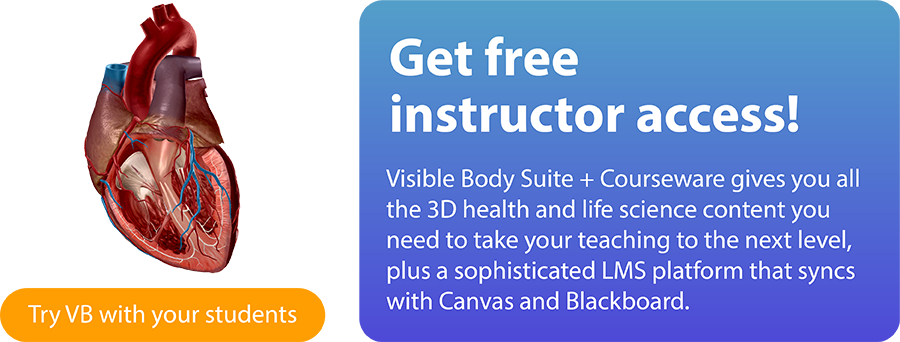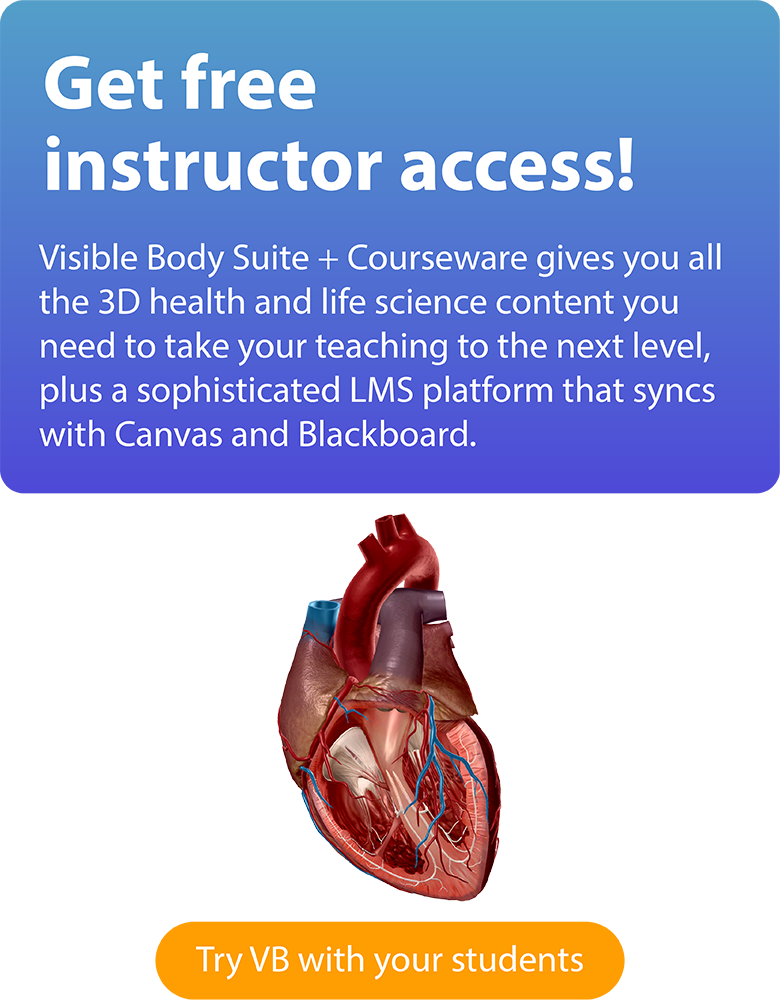How to Teach Renal System Anatomy & Physiology with Visible Body
Posted on 10/11/24 by Sarah Boudreau
When it comes to teaching A&P, some structures and processes are more difficult than others. The anatomy and physiology of the kidneys is one of the more challenging parts of an A&P course, but in this blog post, we’ll show you how Dr. Cindy Harley of Metropolitan State University makes teaching the renal system simpler and more engaging with Visible Body.
"Renal physiology can be so hard to teach, your teaching can wind up straight in the toilet," Dr. Harley joked.
We’ll summarize the fantastic active learning webinar Dr. Harley recently gave on this subject, but if you want to view it in full, check out the video below.
Start with outcomes
Dr. Harley began the webinar by asking participants to chime in with their learning outcomes. Participants reported that they want their students to understand processes like:
- Nephron structure
- Urine formation
- Glomerular pressure
- Countercurrent multiplier
- Filtration reabsorption
- Filtration rates
- Kidney disease
Dr. Harley recommended starting with learning outcomes and working backwards to design a lesson using the materials and tools in Visible Body Suite and Courseware.
"Just because you're using Visible Body doesn't mean you'll have to change your learning outcomes. If we start with the learning outcomes and build the lesson, we're going to build a better lesson than trying to follow a book,” she said.
With those desired outcomes in mind, it’s time to plan a lesson where students take an active role in the learning process. A lesson typically consists of three parts—work students finish before class, activities students complete in class, and an assessment.
Let’s dive into how you can incorporate active learning into all three parts of a renal system lesson.
Active learning before class even begins
Traditionally, students prepare for class by reading a chapter in a book or watching a lecture video, but Dr. Harley challenges instructors to go deeper. Dr. Harley used an example of a student who read a chapter in a textbook and highlighted nearly all the text. That student read the material, but wasn’t using metacognition and reflection to prioritize information.
Before assigning materials, instructors should ask:
- How is the student interacting with the materials?
- Are they making connections?
- Are they reflecting?
The next step is to look at what materials are available. Dr. Harley pointed out the following resources in VB Suite:
- Bite-sized videos that provide a good introduction to a process
- 3D models that students can rotate, dissect, and explore
- Histology slides
- Pathology models
- Tours to walk students through concepts

Premade assignment in Courseware.
Dr. Harley suggested starting with the filtration and absorption and secretion videos, the nephron function Tour, and then ending with the acute tubular necrosis pathology model. With the pathology model, instructors have students connect ideas in new ways, asking, “Now that you understand this process, how would this condition affect the patient?”
"Instead of using a textbook that will get over-highlighted, we're going to watch this video, read through this tour, dissect these structures, and explain this pathology. [...] Your student, instead of reading and highlighting, is now getting actively engaged, and it's capturing their active curiosities,” Dr. Harley explained.
Through VB Courseware, instructors can also assign links, PDFs, and other resources.
Dr. Harley links to content like other simulations, shared Google Docs that her students can work through together, and OpenStax articles. Another important element of Dr. Harley’s Courseware course is guided notes.
"I tend to work with a lot of early learners and nontraditional students, so sometimes, it's about teaching the process of studenting and modeling what that looks like,” she explained.
Using assignments in Courseware, instructors can guide students through 3D models, animations, and slides. In assignments, students can follow their curiosity and explore models by tagging, dissecting, and learning more about structures while the instructions and sequence of activities make sure each student stays on task to achieve learning objectives.

Premade urine production assignment in Courseware.
"When you move to a digital textbook, the digital textbook is like a PDF of the traditional textbook. This is the next level: You've got text, the instructor can modify that text, and you've got these models students can interact with,” Dr. Harley said. "We can tell students how to interact with the model—we can be over their shoulder. If [writing instructions for] all of these models seems daunting, there's a package you can start from.”
It’s a lot of work to build courses and assignments from scratch, but premade content doesn’t always align with your teaching. Luckily, premade content in Courseware—like courses and assignments—are customizable, and Dr. Harley encourages instructors to use premade content as a base to build out your desired course.
Renal system activities in the classroom
Dr. Harley says that she’s trying to move away from long lectures and static presentations.
One way she has done this is by creating a custom Flashcard Deck she moves through as she lectures. She shares that Deck with her students for reference, or she gives them a blank Deck to modify and annotate during class as a way of taking notes.

Screenshot from Dr. Harley's webinar.
When it comes to in-class activities, the sky’s the limit. In addition to quiz games like “pin the tail on the structure” using Kahoot!, Dr. Harley uses several activities to teach the renal system.
Card sorting. Dr. Harley prints out notecards with the names of anatomical structures and asks her students to:
- Arrange the cards in order of where the structures are in urine flow
- Match to anatomy
- Match to function
- Pin to model
As students work through these activities, they can use VB Suite as a reference tool.
“Instead of open book, it's open Visible Body,” she explained.
Drawing. Groups of Dr. Harley’s students use large whiteboards and markers to draw structures and illustrate physiological processes. After they’ve finished, each group passes their whiteboard to another group for a peer review process where they correct each other’s work.
Build a glomerulus. Visualization is hard, but Dr. Harley asks her students to get hands-on and use their problem-solving skills to understand glomerular filtration. She uses common items to illustrate glomerular filtration and show students how to change the filtration depending on the constriction or dilation of the arterioles.
In one version, she uses lab tubing to connect a “glomerulus” to a sink. Pinching the tube shows dilation versus constriction.
In another version, she uses plastic bottles, scissors, glue, and random ingredients in her pantry. She cuts the bottles in half, glues together the top halves, and pokes holes into the sides. Then she cuts different sized holes in the caps and begins connecting the bottles together.
She places dried beans, oats, and similar pantry items into the first bottle to represent materials in the blood like sodium and urea. By rotating the bottles and letting the materials sift through the holes, she illustrates filtration.
Be the transporter. In this activity, Dr. Harley uses tape to make the rough shape of a nephron on the floor. Cards represent the external environment, and cards in a basket represent the interior.
Moving the basket down from 300mOsm to 600mOsm to 900mOsm, she asks her students to balance the number of water cards on the exterior and interior.

Screenshot from Dr. Harley's webinar.
On the ascending limb, students balance the number of solutes as they work their way back up. This activity helps students understand permeability and the concentration gradient.
Dr. Harley brings up several ways to expand on this activity, including:
- What if the loop was longer? Shorter?
- How can we make this model more accurate?
- Add glucose
- Add the vasa recta
Active assessment
When it comes to assessment, there are traditional handouts, quizzes, and tests, but then there are more active ways of assessing students’ knowledge of a subject. Dr. Harley recommends a couple methods.
Group quizzing. Have students take a quiz individually, then ask them to flip it over and work through the questions as a group.
Student-led lessons. Give students a list of topics to hit and let them lead class.
Pathologies. Give a group of students a scenario involving a pathology and ask them to extrapolate.
Creating communications. Ask students to create a pamphlet explaining a concept to a general audience.
Make a meme. Each meme must have correct information and must be accompanied with a two-sentence explanation of what it shows. This activity is a great way to get students interacting (and laughing) with each other.
Dr. Harley also talked about sketch notes and video walkthroughs—you can learn more about these two options in our blog post on alternative assessments!
Wrap-up
We’d like to say a huge thank you to Dr. Cindy Harley for leading such an in-depth, engaging webinar.
If you’d like to try Visible Body in your classroom, click the banner below to get a free instructor trial!


Want more teaching ideas? Check out these blog posts!
- 3D Urinary System Lesson Plan with Visible Body
- Extra Credit Assignment: Bony Landmarks Flashcards
- At the Heart of Adaptation: A Comparative Anatomy Lesson Plan
- 3 Ways to Use QR Codes in the Classroom with Visible Body Suite
Be sure to subscribe to the Visible Body Blog for more anatomy awesomeness!
Are you an instructor? We have award-winning 3D products and resources for your anatomy and physiology course! Learn more here.



